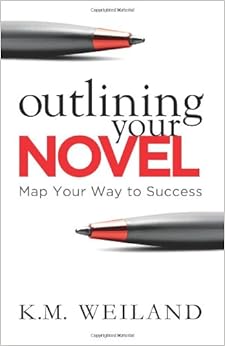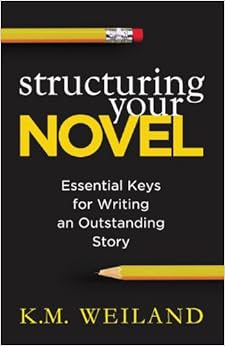*Please note this is a two part series. Part one of the series was published on Monday, December 14th.*
On Monday, I gave a brief overview of K.M. Weiland’s fantastic writing resource Outlining Your Novel. Today, I’ll give a peek into her follow-up writing book Structuring Your Novel.
 Let’s just get the argument out of the way first. Kristin, you’ve already said Outlining Your Novel was fantastic for me to have. How is Structuring Your Novel any different? Doesn’t she just repackage the material covered in Outlining Your Novel in this book?
Let’s just get the argument out of the way first. Kristin, you’ve already said Outlining Your Novel was fantastic for me to have. How is Structuring Your Novel any different? Doesn’t she just repackage the material covered in Outlining Your Novel in this book?
First, Structuring Your Novel is, surprisingly, completely different than Outlining Your Novel. I can only think of a handful of times where Weiland references something from Outlining Your Novel, but usually to note something you should’ve already have done in the pre-writing stage. Think of it this way: Outlining Your Novel is about conceptualization, like blueprinting a future house. Structuring Your Novel is actually building said house. They are similar in that they are both processes of making a house, but completely different in action.
 K.M. Weiland breaks up her book into two sections: the macros of story structure and the micros of story structure. The macros include: the hook, the beginning, the first act, the first plot point, the second and third acts, the climax, the resolution, and the ending. Some of these macros are similar, but Weiland breaks down their differences, what percentage into your book they should occur, and why each are important. She also outlines some common mistakes and pitfalls, how to avoid them, and how to fix them.
K.M. Weiland breaks up her book into two sections: the macros of story structure and the micros of story structure. The macros include: the hook, the beginning, the first act, the first plot point, the second and third acts, the climax, the resolution, and the ending. Some of these macros are similar, but Weiland breaks down their differences, what percentage into your book they should occur, and why each are important. She also outlines some common mistakes and pitfalls, how to avoid them, and how to fix them.
The second half of Structuring Your Novel consists of the micros, or scene and sentence structure. Once you’ve structured the overall story, now your attention needs to be paid to each individual scene and chapter. You want these micros to mirror the bigger story: the highs and the lows. Weiland specifically examines and defines The Scene and The Sequel, which I can assure you I did not learn in college. She also briefly examines sentence structure, getting super-micro with structure.
How important is structure, really? It’s the difference between the second book in a trilogy being the ugly stepsister, or as brilliantly important as The Two Towers. How you structure the events in your story will equate to how believable your characters and their actions are.
“Structure is required in all art. Dancing, painting, singing, you name it — all forms require structure. Writing is no different. To bring a story to its full potential, authors must understand the form’s limitations, as well as how to put its many parts into the proper order to achieve maximum effect.” (From the Introduction)
In summary, K.M. Weiland’s books on writing put information on outlining and structure in two, easily accessible locations. What I love best about Weiland’s overarching style in these books is that it is humble and unassuming. She draws from a huge breadth of knowledge on writing, drawing from other writers and other authors of books on writing, and presents the information as clear as a bell.
If you want a clear, no nonsense approach to the basics of prewriting and structuring a story, you need these books.

Again, most excellent!
Thanks, Dad!
Pingback: We’ll Call it a Win – The Fictorians